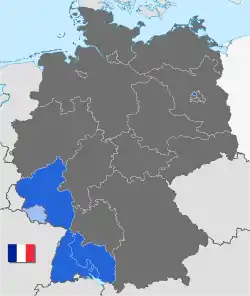French occupation zone in Germany
The French occupation zone in Germany (German: Französische Besatzungszone) was one of the Allied-occupied areas in Germany after World War II.
| French occupation zone in Germany Französische Besatzungszone Deutschlands | |||||||||||||
|---|---|---|---|---|---|---|---|---|---|---|---|---|---|
| Military occupation zone of the French part of Allied-occupied Germany | |||||||||||||
| 1945–1949 | |||||||||||||
.svg.png.webp) | |||||||||||||
 French occupation zone, in blue | |||||||||||||
| Capital | Baden-Baden | ||||||||||||
| Government | |||||||||||||
| • Type | Military Occupation | ||||||||||||
| Military governors | |||||||||||||
• 1945 | Jean de Lattre de Tassigny | ||||||||||||
• 1945–1949 | Marie-Pierre Kœnig | ||||||||||||
| Historical era | Post-World War II Cold War | ||||||||||||
| May 8, 1945 1945 | |||||||||||||
• Federal Republic of Germany established | May 23, 1949 1949 | ||||||||||||
| May 5, 1955 | |||||||||||||
| |||||||||||||
| Today part of | |||||||||||||


History
In the aftermath of the Second World War, Winston Churchill, Franklin D. Roosevelt and Joseph Stalin met at the Yalta Conference to discuss Germany's post-war occupation. At the insistence of Charles de Gaulle and the Provisional Government of the French Republic, they allocated a zone to France.[1] Stalin agreed on the condition that the French zone was to be formed out of American and British zones.
To create the occupation zone, the British ceded the Saarland, the Palatinate, and territories on the left bank of the Rhine to Remagen (including Trier, Koblenz, and Montabaur). The Americans ceded land south of Baden-Baden, land south of the Free People's State of Württemberg (which became Württemberg-Hohenzollern), the Lindau region on Lake Constance, and four regions in Hesse east of the Rhine.[1] French Forces in Germany took possession of the area on July 26, 1945.[1]
In April and May, the French 1st Army had captured Karlsruhe and Stuttgart and conquered territory extending to Hitler's Eagle's Nest and western Austria. In July, the French ceded Stuttgart to the Americans in exchange for control of cities west of the Rhine (including Mainz and Koblenz).[2] This resulted in two barely-contiguous areas of Germany along the French border, which met at a point along the Rhine. Three German states were established: Rheinland Pfalz in the northwest, Württemberg-Hohenzollern in the southeast, and South Baden in the southwest. Württemberg-Hohenzollern and South Baden later formed Baden-Württemberg when they joined with Württemberg-Baden in the American Zone.
The French occupation zone included the Saar Protectorate, which was separated on February 16, 1946. By December 18 of that year, customs controls were established between the Saar area and Allied-occupied Germany. Also included in the French zone was the town of Büsingen am Hochrhein, a German exclave separated from the rest of the country by a narrow strip of neutral Swiss territory. On February 9, 1945, the Berlin districts of Reinickendorf and Wedding were assigned to the French.[3] By the end of October 1946, the French zone had a population of approximately five million:
- Rheinland Pfalz: 2.7 million
- Baden (South Baden): 1.2 million
- Württemberg-Hohenzollern: 1.05 million
The Saar Protectorate had an additional 0.8 million people.[4] The French Education Directorate in Germany was created to educate the children of military and civilian families.
Zone commanders
After representing the French during the signing of the German Instrument of Surrender, which officially ended the conflict in the European theater, Jean de Lattre de Tassigny briefly served as commander-in-chief of the French Forces in Germany[5] before the role was assumed by Marie-Pierre Kœnig.[6] André François-Poncet, ambassador to Germany during the 1930s, was named French high commissioner to West Germany after the war. François-Poncet's position was later elevated to ambassador, and he served in that capacity until 1955.[7][8] Claude Hettier de Boislambert, Guillaume Widmer and Pierre Pène were governors of the Rhineland-Palatinate, Württemberg-Hohenzollern and Baden, respectively.[9]
See also
References
- H. Pennein-Engels (1994). "The military presence in Germany from 1945 to 1993" (Pdf). University of Metz - Faculty of Letters and Human Sciences. Retrieved July 8, 2015.
- de Gaulle, Charles (1959). Mémoires de Guerre: Le Salut 1944-1946. Plon. pp. 170, 207.
- "French Military Government of Berlin" (Pdf). Retrieved July 9, 2015.
- "I. Gebiet und Bevölkerung". Statistisches Bundesamt. Wiesbaden.
- H. Pennein-Engels (1994). "The military presence in Germany from 1945 to 1993" (Pdf). University of Metz - Faculty of Letters and Human Sciences. p. 29. Retrieved July 8, 2015.
- Reinisch, J. (2013). "Chapter 8: The Forgotten Zone: Public Health Work in the French Occupation Zone". The Perils of Peace: The Public Health Crisis in Occupied Germany. Oxford (UK): OUP Oxford.
- Richard Gilmore (1973). France's Postwar Cultural Policies and Activities in Germany. Balmar Reprographics. p. 41.
- Creswell, Michael; Trachtenberg, Marc. "France and the German Question, 1945–1955" (Pdf). p. 16. Retrieved June 27, 2020.
- Karin Graf (2003). Die Bodenreform in Württemberg-Hohenzollern nach dem Zweiten Weltkrieg. Tectum Verlag DE. p. 19.
Further reading
- Corine Defrance, La Politique culturelle de la France sur la rive gauche du Rhin, 1945–1955, Presses universitaires de Strasbourg, 1994.
- Compte rendu du deuxième Congrès de l'Organisation des fonctionnaires résistants en Allemagne, Höllhof, 1949
- Hillel, Marc, L'occupation française en Allemagne 1945-1949, Balland, 1983.